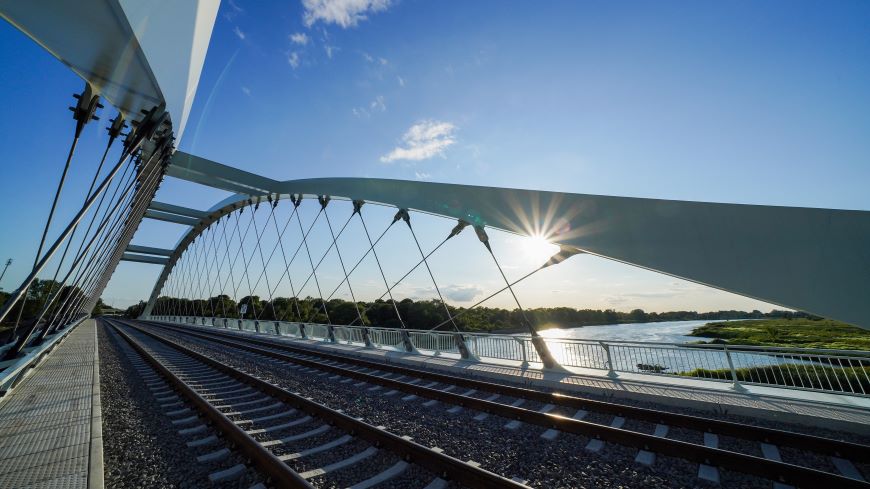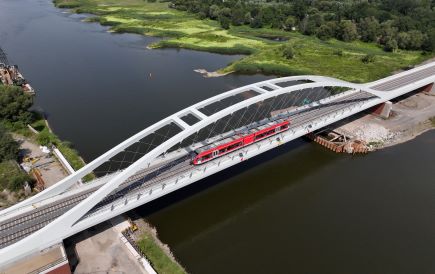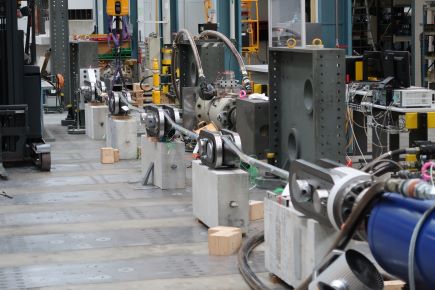Empa innovation in bridge construction
Award-winning railway bridge with Swiss carbon cables
The multi-award-winning Oder Bridge near Küstrin is supported by a network arch with prestressed carbon cables. These ultra-lightweight yet extremely durable tension members made of carbon fiber reinforced polymers (CFRP) were largely developed, tested, and evaluated at Empa.

A gleaming white network arch with a span of 130 meters supports the new border bridge near Küstrin. 88 carbon hangers stabilize the filigree construction over the Oder River. These tension members made of carbon fiber reinforced polymers (CFRP) were used for the first time worldwide in a railway bridge – developed by Empa spin-off Carbo-Link and tested and evaluated at Empa. The innovative material not only enables a particularly material-efficient construction method, but also significantly reduces CO₂ emissions compared to a conventional steel structure. The bridge has received two awards for this groundbreaking design – the British Bridges International Award and the German Bridge Construction Prize.
Lightweight carbon instead of heavy steel

According to the jury of the German Bridge Construction Prize, the Küstrin Oder Bridge is not only considered an engineering masterpiece but is also pioneering in terms of economy and sustainability. The 88 carbon hangers significantly reduce the weight compared to conventional flat steel hangers. This is because CFRP offers higher tensile strength and better fatigue resistance than steel – while also being significantly lighter. This opens up new design freedoms, as the airy, transparent appearance of the Oder Bridge impressively demonstrates. In addition, the material savings reduce construction costs and maintenance requirements in the long term.
Overall, the use of CFRP hangers saved around 500 tons of steel and 1,350 tons of reinforced concrete in the bridge's overall structure. A sustainability study by Urs Meier, CFRP pioneer and former member of Empa's Directorate, shows that the carbon version saves around 20 percent of CO₂ emissions compared to a steel structure.
High technical requirements for railway bridges

The railway bridge over the Oder is a double-track network arch bridge in composite construction, equipped with prestressed CFRP hangers. Although such carbon cables have already been used on another bridge, this is the first time they have been used worldwide for heavy rail freight traffic. Trains can now pass over the structure at speeds of up to 120 kilometers per hour – which required extensive testing and complex approval procedures.
According to Lorenz Haspel, the project manager responsible at the engineering firm schlaich bergermann partner, this carbon bridge would not have been possible without Empa. The innovative CFRP hangers come from the Empa spin-off Carbo-Link in Fehraltorf – founded by Andreas Winistörfer, CEO and former Empa doctoral student – and have now been used for the second time in a network arch bridge. “We used such carbon cables for the first time as highly stressed tension members in a network arch on the city railway bridge in Stuttgart,” says Haspel.
The fatigue tests for the Oder bridge were largely carried out by a team from Empa's Structural Engineering lab led by Robert Widmann and Dimitri Ott in Empa's construction hall – confirming the necessary fatigue strength of the innovative CFRP material. Giovanni Terrasi, head of Empa's Mechanical Systems Engineering lab, also worked with Christian Affolter to prepare the technical report for the now award-winning bridge. “We have thus laid the foundation for a new generation of filigree network arch bridges with carbon hangers as load-bearing elements,” Terrasi is convinced.
Empa
Prof. Dr. Giovanni Terrasi
Mechanical Systems Engineering
Phone +41 58 765 41 17
Prof. Urs Meier
Phone +41 58 765 41 00
-
Share






